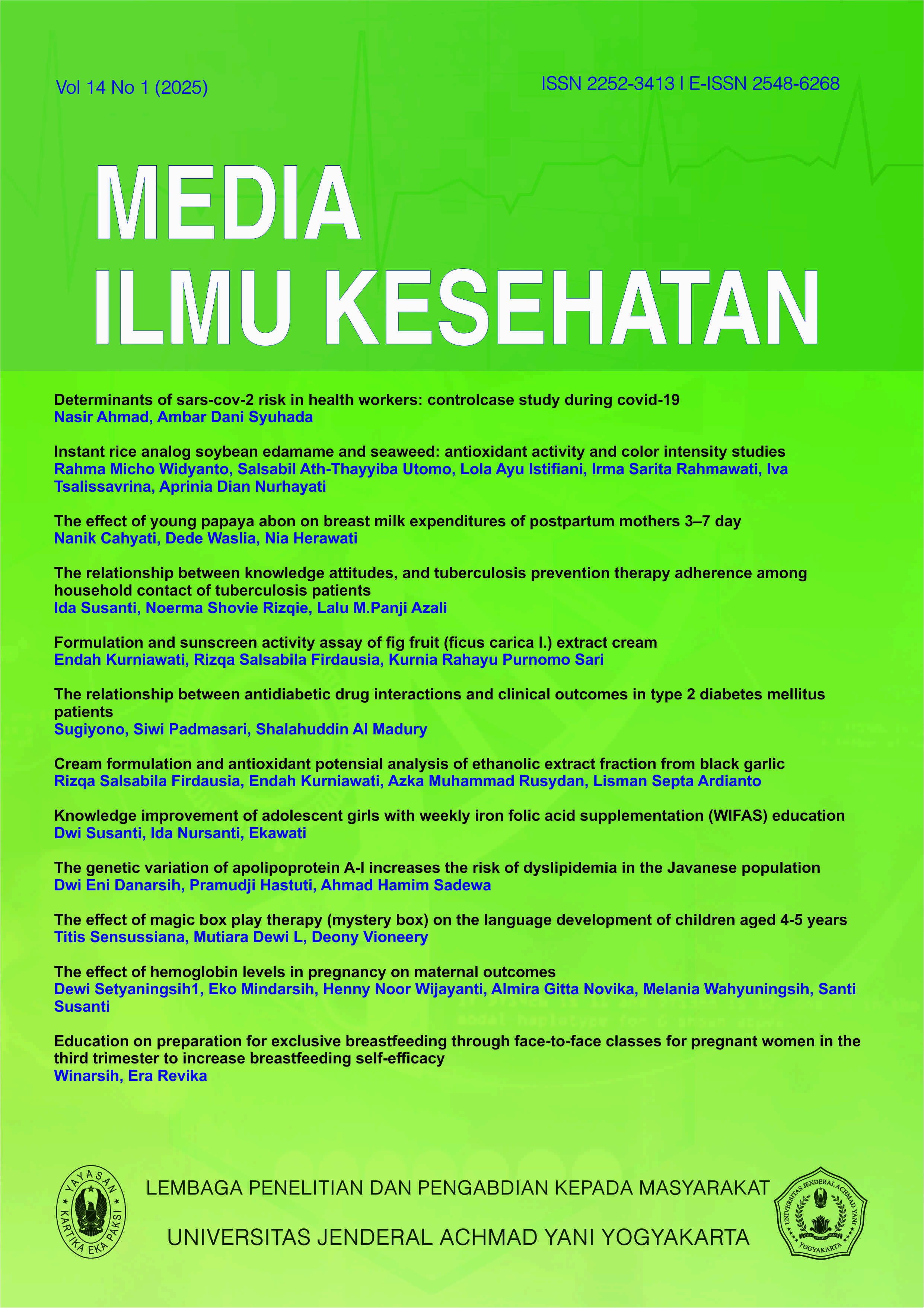Education on preparation for exclusive breastfeeding through face-to-face classes for pregnant women in the third trimester to increase breastfeeding self-efficacy
DOI:
https://doi.org/10.30989/mik.v14i1.1430Keywords:
Bresfeeding, Education, Exclusive Breastfeeding, Self-EfficacyAbstract
Background: Mother's milk makes children have potential, have stable emotions, are spiritually mature, and have good social development. It is hoped that educational classes will be able to become a means of obtaining information, knowledge and become a means of discussion about the problems faced by breastfeeding mothers and will further help increase self-efficacy in providing exclusive breastfeeding to babies.
Objective: This study aims to analyze differences in Breastfeeding Self-Efficacy in third trimester pregnant women before and after being given education on preparing for exclusive breastfeeding through face-to-face mother classes.
Method: The design in this study uses a quasi-experiment method with a one group pre test - post test design model. The sample in this study is the total population, namely all pregnant women in the third trimester who are willing to be research respondents from the time the education begins until it is completed. Totaling 30 respondents
Results: The results of the paired sample t-test analysis show that the p-value is <0.012. So it can be concluded that the p-value is 0.012 < 0.05.
Conclusion: There is a significant effect of providing education on preparation for exclusive breastfeeding through face-to-face classes for pregnant women on breastfeeding self-efficacy
References
1. Wijaya FA. ASI Eksklusif: Nutrisi Ideal untuk Bayi 0-6 Bulan. Cermin Dunia Kedokt. 2019;46(4):296-300. https://media.neliti.com/media/publications/399945-asi-eksklusif-nutrisi-ideal-untuk-bayi-0-18d0db99.pdf
2. Keputusan Menteri Kesehatan Republik Indonesia Nomor 450 tentang Pemberian ASI Eksklusif. .
3. Republik Indonesia. ASI Eksklusif. Undang-undang No.33 Tahun 2012 Pasal 13 Tentang Pemberian Air Susu Ibu. .
4. Utami R. Mengenal ASI Eksklusif. Trubus Agriwidya; 2019. https://books.google.co.id/books?id=zWDmh8QBIkMC&printsec=frontcover&hl=id#v=onepage&q&f=false
5. Bandura A. Self-Efficacy : The Exercise of Control. W.H Freeman & Company; 1997.
6. Riyanti E, Nurlaila N, Astutiningrum D. Pengaruh Edukasi Breastfeeding Ibu Post Partum Terhadap Breasfeeding Self Efficacy. J Ilm Kesehat Keperawatan. 2019;14(3):96. doi:10.26753/jikk.v14i3.350
7. Yuliani DR, Winarso SP, Amalia R, Naufal AF. Media Edukasi Video Untuk Meningkatkan Breastfeeding Self-Efficacy (Efikasi Dini Menyusui). J Sains Kebidanan. 2022;4(2):79-84. https://ejournal.poltekkes-smg.ac.id/ojs/index.php/JSK/article/view/9289/2792
8. Salamah U, Prasetya PH. Faktor-faktor yang Mempengaruhi Ibu dalam Kegagalan Pemberian ASI Eksklusif. J Kebidanan. 2019;5(3):199-204. https://ejurnalmalahayati.ac.id/index.php/kebidanan/article/view/1418/pdf
9. Sustainable Development Goals (SDGs). .; 2017. https://sdg2030indonesia.org/
10. Dinas Kesehatan Boyolali. Profil Dinas Kesehatan Kabupaten Boyolali.; 2021. https://dinkes.boyolali.go.id/doc/profil/PRofil_Dinkes_2021_Cetak_Full.pdf
11. Sugiyono. Metode Penelitian Kuantitatif Kualitatif Dan R&D. (M.Dr.Ir.Sutopo S.Pd (ed) ; ke2 ed); 2019.
12. BKKBN. Usia Pernikahan Ideal 21-25 Tahun. Jakarta : BKKBN.
13. Carolan, M ; Nelaon M. Menjadi Ibu Pertama di atas Usia 35 Tahun: Mempertanyakan Hubungan Antara Usia Ibu dan Risiko Kehamilan. Health Care Women Int. 2007;28(6):534-555.
14. Rinata E. Karakteristik Ibu (Usia, Paritas, Pendidikan) Dan Dukungan Keluarga Dengan Kecemasan Ibu Hamil Trimester III. Medisains J Ilm Ilmu-ilmu Kesehat. 2018;16(1):14-20. https://jurnalnasional.ump.ac.id/index.php/medisains/article/view/2063/1955
15. Aprilia D, Fitriah A. Efektivitas Kelas Edukasi (KE) Menyusui untuk Meningkatkan Efikasi Diri Ibu Menyusui dalam Memberikan ASI Ekslusif di Banjarmasin. J Stud Gend dan Anak. 2017;4(2):118-122. https://jurnal.uin-antasari.ac.id/index.php/muadalah/article/view/2575/1755
16. McKinley EM, Knol LL, Turner LW, et al. The Prenatal Rating of Efficacy in Preparation to Breastfeed Scale: A New Measurement Instrument for Prenatal Breastfeeding Self-efficacy. J Hum Lact. 2019;35(1):21-31. https://www.researchgate.net/profile/Erin-Mckinley/publication/327875213_The_Prenatal_Rating_of_Efficacy_in_Preparation_to_Breastfeed_Scale_A_New_Measurement_Instrument_for_Prenatal_Breastfeeding_Self-efficacy/links/6511832ac05e6d1b1c313072/The-Prenatal-R
17. Martina I, Jainurakhma J. Tingkat Breastfeeding Self Efficacy Terhadap Motivasi Ibu Nifas Post-OP Sectio Secaria dalam Pemberian ASI Eksklusif di Wilayah Kerja Puskesmas Kepanjen Malang. J Ilmu Kesehat MAKIA. 2021;11(2):27--34.
18. Chan MY, Ip WY, Choi KC. The effect of a self-efficacy-based educational programme on maternal breast feeding self-efficacy, breast feeding duration and exclusive breast feeding rates: A longitudinal study. Midwifery. 2016;36:92-98. doi:10.1016/j.midw.2016.03.003
19. Metin A, Baltacı N. The effects of video-assisted breastfeeding education given to primiparous pregnant women on breastfeeding self-efficacy: randomized control study. BMC Pregnancy Childbirth. 2024;24(1):142. doi:10.1186/s12884-024-06317-1
20. Tyastuti S, Wahyuningsih HP. Asuhan Kebidanan Kehamilan. Pusdik SDM Kesehatan; 2016.
21. Padmawati IA. Manajemen Laktasi.; 2016.
22. Tiwari K, Savarna N, Khanam I. A study on knowledge of breast feeding and effect of antenatal counselling on exclusive breast feeding in primigravida mothers. Int J Reprod Contraception, Obstet Gynecol. 2018;7(8):3311--3315. doi:http://dx.doi.org/10.18203/2320-1770.ijrcog20183336
Downloads
Published
How to Cite
Issue
Section
License
Copyright (c) 2025 MEDIA ILMU KESEHATAN

This work is licensed under a Creative Commons Attribution-ShareAlike 4.0 International License.
Articles received and published by the Media Ilmu Kesehatan are by the publication, the copyright of the article is fully transferred to the Media Ilmu Kesehatan. All operational forms such as printing, publication, and distribution of hard file journals are carried out by the Media Ilmu Kesehatan. Articles that have finished the review process and have been declared accepted by the journal manager or editor will be asked to fill out a statement of submission of copyright by the journal secretary to the main author or correspondent author. The statement of transfer of copyright is signed with a seal and sent via email to journalmik2018@gmail.com and contacted the admin of the journal to be followed up on archiving. Journal managers and editors have the right to edit the manuscript according to the provisions of the writing rules in the Media Ilmu Kesehatan.
Articles that have been declared accepted either online through the author's account on the OJS website https://ejournal.unjaya.ac.id/index.php/mik or a letter of receipt of the article (LOA), as well as those that have been published on OJS are not allowed to be published in other journals, or proceedings. The number of authors with more than one and as the main author or designated as the correspondent writer must have coordinated with members of the research team. The order of the authors submitted in the article as the author of one, two, three and so on cannot be changed when the article is published unless an error occurs in the technical operation of the journal.












